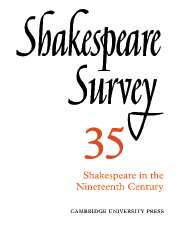Book contents
- Frontmatter
- Before the Shakespeare Revolution: Developments in the Study of Nineteenth-Century Shakespearian Production
- The Meininger Company and English Shakespeare
- Shakespeare at the Burgtheater: From Heinrich Anschütz to Josef Kainz
- Shakespeare on the Melbourne Stage, 1843-61
- Shakespeare in Hazlitt’s Theatre Criticism
- Characterization of the Four Young Lovers in A Midsummer Night’s Dream
- Queenly Shadows: On Mediation in Two Comedies
- Language, Theme, and Character in Twelfth Night
- The Art of the Comic Duologue in Three Plays by Shakespeare
- ‘Spanish’ Othello: The Making of Shakespeare’s Moor
- Ferdinand and Miranda at Chess
- Shakespeare’s Latin Citations: The Editorial Problem
- The Theatre at Christ Church, Oxford, in 1605
- Interpretations of Shakespearian Comedy, 1981
- The Year's Contributions to Shakespearian Study 1 Critical Studies
- 2 Shakespeare’s Life, Times and Stage
- 3 Textual Studies
- Index
- Plate Section
Shakespeare’s Latin Citations: The Editorial Problem
Published online by Cambridge University Press: 28 March 2007
- Frontmatter
- Before the Shakespeare Revolution: Developments in the Study of Nineteenth-Century Shakespearian Production
- The Meininger Company and English Shakespeare
- Shakespeare at the Burgtheater: From Heinrich Anschütz to Josef Kainz
- Shakespeare on the Melbourne Stage, 1843-61
- Shakespeare in Hazlitt’s Theatre Criticism
- Characterization of the Four Young Lovers in A Midsummer Night’s Dream
- Queenly Shadows: On Mediation in Two Comedies
- Language, Theme, and Character in Twelfth Night
- The Art of the Comic Duologue in Three Plays by Shakespeare
- ‘Spanish’ Othello: The Making of Shakespeare’s Moor
- Ferdinand and Miranda at Chess
- Shakespeare’s Latin Citations: The Editorial Problem
- The Theatre at Christ Church, Oxford, in 1605
- Interpretations of Shakespearian Comedy, 1981
- The Year's Contributions to Shakespearian Study 1 Critical Studies
- 2 Shakespeare’s Life, Times and Stage
- 3 Textual Studies
- Index
- Plate Section
Summary
T. W. Baldwin’s monumental and authoritative study, William Shakspere’s Small Latine & Lesse Greeke (2 vols., Urbana, 1944), has finally established the extent of Shakespeare’s competence in Latin. His thorough grounding in the school authors of his day, and the extent to which the Latin-dominated curriculum of the Elizabethan grammar school permeated his consciousness and his writing, can no longer be doubted. Baldwin’s conclusions have been reinforced by J. A. K. Thomson’s Shakespeare and the Classics (London, 1952), and, more recently, by J. E. Hankins in Backgrounds of Shakespeare’s Thought (Hassocks, 1978). Hankins, in a thoughtful study of Shakespeare’s reading, concludes that ‘Shakespeare had the linguistic equipment to read Latin if he cared to do so’ (p. 13), and argues persuasively that Shakespeare’s knowledge of untranslated Latin texts can be discerned from a reading of his plays.
- Type
- Chapter
- Information
- Shakespeare Survey , pp. 119 - 128Publisher: Cambridge University PressPrint publication year: 1982

